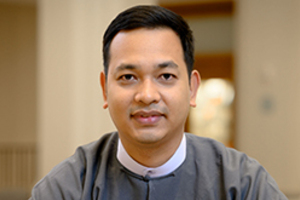
First-year MGA student Aung Myo Hein is a peace practitioner with more than a decade of experience in conflict prevention, refugee rights, environmental disaster response, and humanitarian aid distribution. Aung Myo has worked with powerhouse NGOs including Search for Common Ground and USAID, and is dedicated to fostering peace and progress in his home country of Myanmar. In this student Q&A, Aung Myo reveals his journey to peacebuilding, his decision to pursue a master’s degree, and what he hopes to carry with him after graduation.
What led you to the field of peacebuilding?
As a native of Myanmar, I grew up in conflict. We lived with violence, poverty, and human rights violations, and it has always been my dream to overcome them. In 2008, I worked with the Association of Southeast Asian Nations (ASEAN) Humanitarian Task Force (AHTF) to coordinate and deliver humanitarian aid in response to the Cyclone Nargis disaster. During my work with AHTF, I realized there were multiple dynamics at play with the situation in Myanmar. So, in 2010, I went to Thailand and worked at the Thai-Myanmar border to increase access to education and livelihood for refugees. In 2012, conflict broke out in the Rakhine State, which personally affected my community. This opened my eyes to the importance of conflict transformation and the role of prejudice in communities. I saw the power of peacebuilding on all levels: the country level, the regional level, and the grassroots level. In 2014, when Myanmar started to relax politically, I began working with Search for Common Ground and USAID, playing a role in securing the democratization process, preventing inter-communal conflicts, and promoting an inclusive peace process.
What challenges do you encounter in inclusive and interethnic peacebuilding?
Complexity is an issue. Myanmar is diverse and complicated, which makes it more vulnerable. There is disparity on all levels. We have to explore difficult questions, such as “how do we keep building peace when there are humanitarian crises arising?” and “how do we ensure our humanitarian intervention doesn’t trigger conflict but promotes stability?” When we peacebuild, we challenge and change patterns in a country. Communities must cope with significant degrees of change, and we must ensure change is accepted and aligned with our stakeholders’ priorities.
Why study at the Kroc Institute?
I heard about Kroc through my work with Search for Common Ground. I met with many alumni, who spoke highly of the master’s program. The emphasis on strategic peacebuilding attracted me because, in my experience, peace requires a multi-layered and -sectored approach. Of course, the generous financial and community support was an added bonus; the Kroc Institute truly invests in our scholarship and supports our learning.
What is it like to discuss the situation in your home country in class?
Truthfully, I am happy I can contribute to the discussion. I came here to be a voice for my country. I want to be a bridge between the US and Myanmar. It is important that we talk about our experiences, spread awareness, and learn from others. I find a lot of commonalities with students from places like Syria, Afghanistan and Colombia in my cohort. I can take home advice and stories from these different perspectives.
What have you found to be the most impactful part of your studies thus far?
The classes are great! We have focused on being intently reflective in our practice, to evaluate how to ensure our peacebuilding and interventions are effective. Each class presents a different lens, such as intersectionality and decoloniality, for us to discuss and explore. I really appreciate the various approaches to analyzing conflict and planning peacebuilding activities. The program also promotes creativity, which is essential for peacebuilding work.
Where do you see yourself after graduation?
I want to focus on facilitating reconciliation in the Rakhine state, de-escalating current political violence in Myanmar, and empowering local peacebuilders back home, building on their capacity and prioritizing local expertise.
How would you describe peacebuilding to someone unfamiliar with the concept?
To build peace, you must understand violence. In peacebuilding, we look at violence on multiple levels: direct (visible), structural (institutions, governments), and cultural forms of violence. Through these various lenses, we can create comprehensive, creative, and inclusive solutions to bring people together and decrease future occurrences of violence.